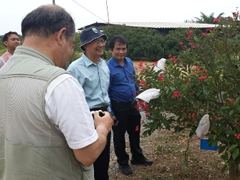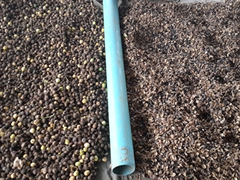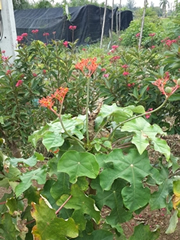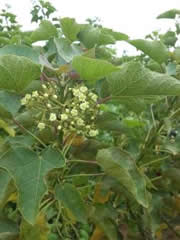- Home
- Technical Cooperation Projects
- Index of Countries
- Asia
- Thailand
- Innovation on Production and Automotive Utilization of Biofuels from Non-Food Biomass
- Project News
- No.7 KASETSART UNIVERSITY Jatropha Pilot Plantation
Project News
2014-09-11
No.7 KASETSART UNIVERSITY Jatropha Pilot Plantation
Kasetsart University won a five-year competitive research grant totaling 20 MBaht (about 625000 USD) during 2011 to 2016 to develop new types/cultivars of jatropha (Jatropha curcas) for use as biofuel and animal feeds. The project "Breeding to Accelerate Domestication of Novel Jatropha for Fuel and Feeds" is being supported by the Crown Property Bureau through the National Science and Technology Development Agency (NSTDA). Kasetsart University Kamphaeng Saen campus has devoted an area of around 10 ha for pilot plantation of elite jatropha lines.
Jatropha curcas is a drought-resistant shrub growing well in marginal/poor soil. The plant is easy to grow and culture, and is able to quickly establish and produce seed for 50 consecutive years. Jatropha seed contains several toxic substances and is thus non-edible for humans, however, the seed has a high oil content that can be used as fuel for diesel engines. Upon oil removal, its seed cake contains as high as 50% high quality protein that can be used in animal feeds.
Thailand introduced a number of Jatropha species from abroad several years ago, and some of them have become indigenous and can be used to improve J. curcas. Currently, Kasetsart University has created more than 1000 different genotypes of novel jatropha by interspecific crossing. They are engineered to have annual growth ranging between 0.50 to 3.0 m with different branching habits (spreading, upright and erect). Depending on their prominent characteristics, they can be utilized either for ornamental purpose, biomass, or oil. Currently, seed yield and oil content have been improved to give at least 50% higher seed and oil yield than the normal jatropha accessions. The new jatropha lines also feature more uniform fruit maturity in the same cluster, but not on different clusters. This facilitates harvesting to cluster rather than individual fruit basis.
The research progress is amazing, so is the jatropha field blooming with beautiful flowers.
 Image of visiting Jatropha Pilot Plantation at Kasetsart University Kamphaeng Saen campus (centre: Professor Peerasak)
Image of visiting Jatropha Pilot Plantation at Kasetsart University Kamphaeng Saen campus (centre: Professor Peerasak)
 Left: Jatropha fruit
Left: Jatropha fruit
Right: Jatropha residue
 Different genotypes enable blooming different color of flowers.
Different genotypes enable blooming different color of flowers.
 Image of Jatropha flowers and fruit
Image of Jatropha flowers and fruit
- About JICA
- News & Features
- Countries & Regions
- Our Work
- Thematic Issues
- Types of Assistance
- Partnerships with Other Development Partners
- Climate Change / Environmental and Social Considerations
- Evaluations
- Compliance and Anti-corruption
- Science and Technology Cooperation on Global Issues
- Research
- JICA Development Studies Program / JICA Chair
- Support for the Acceptance of Foreign HRs / Multicultural and Inclusive Community
- Publications
- Investor Relations
